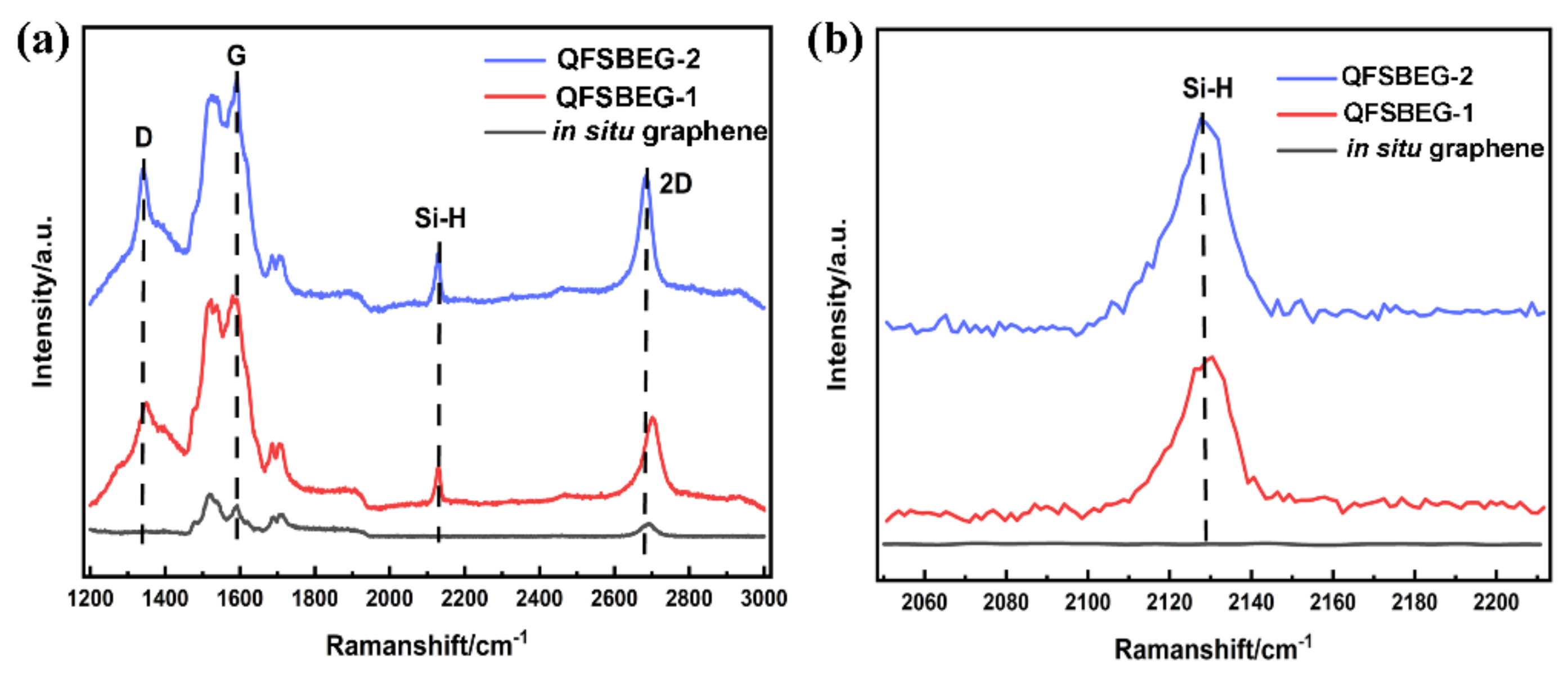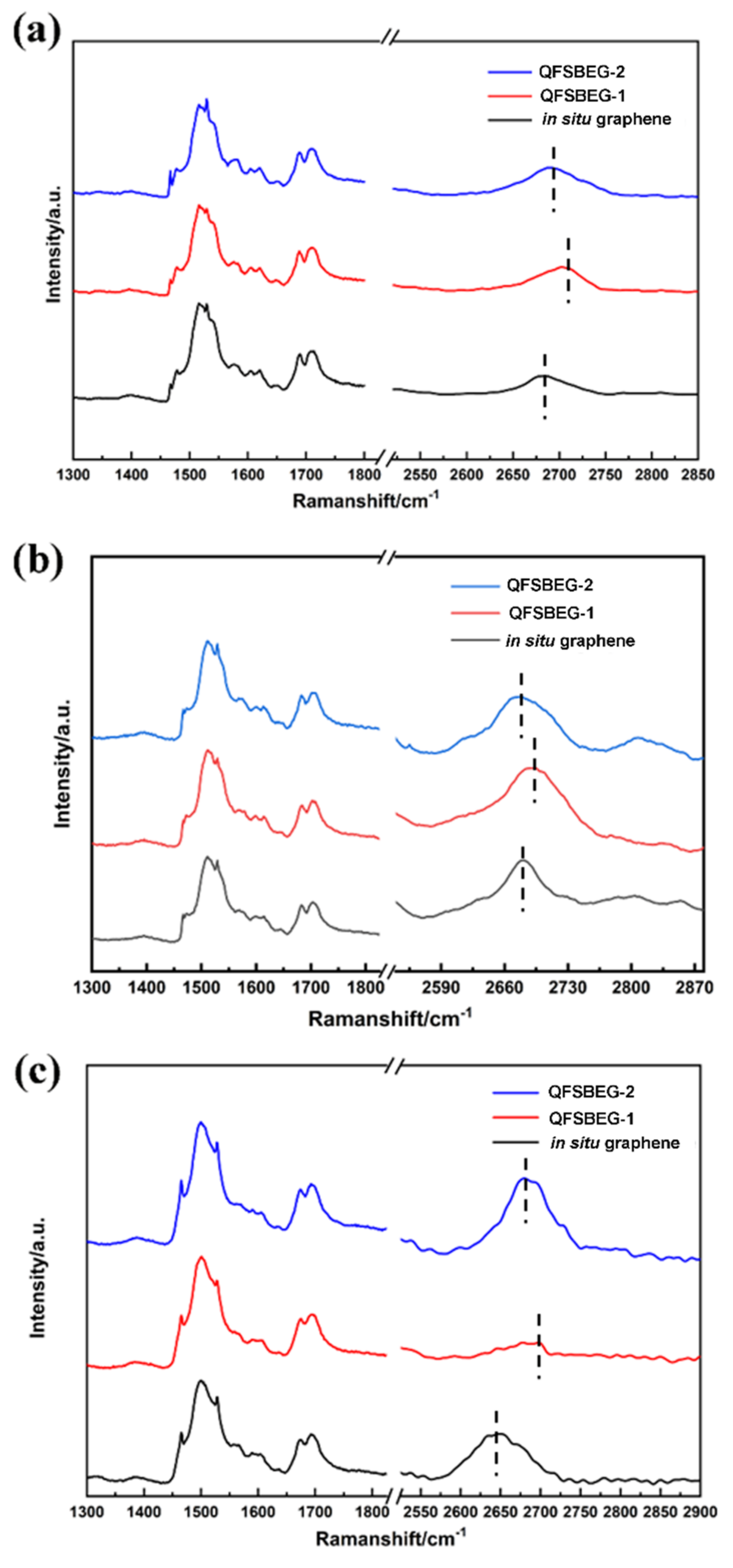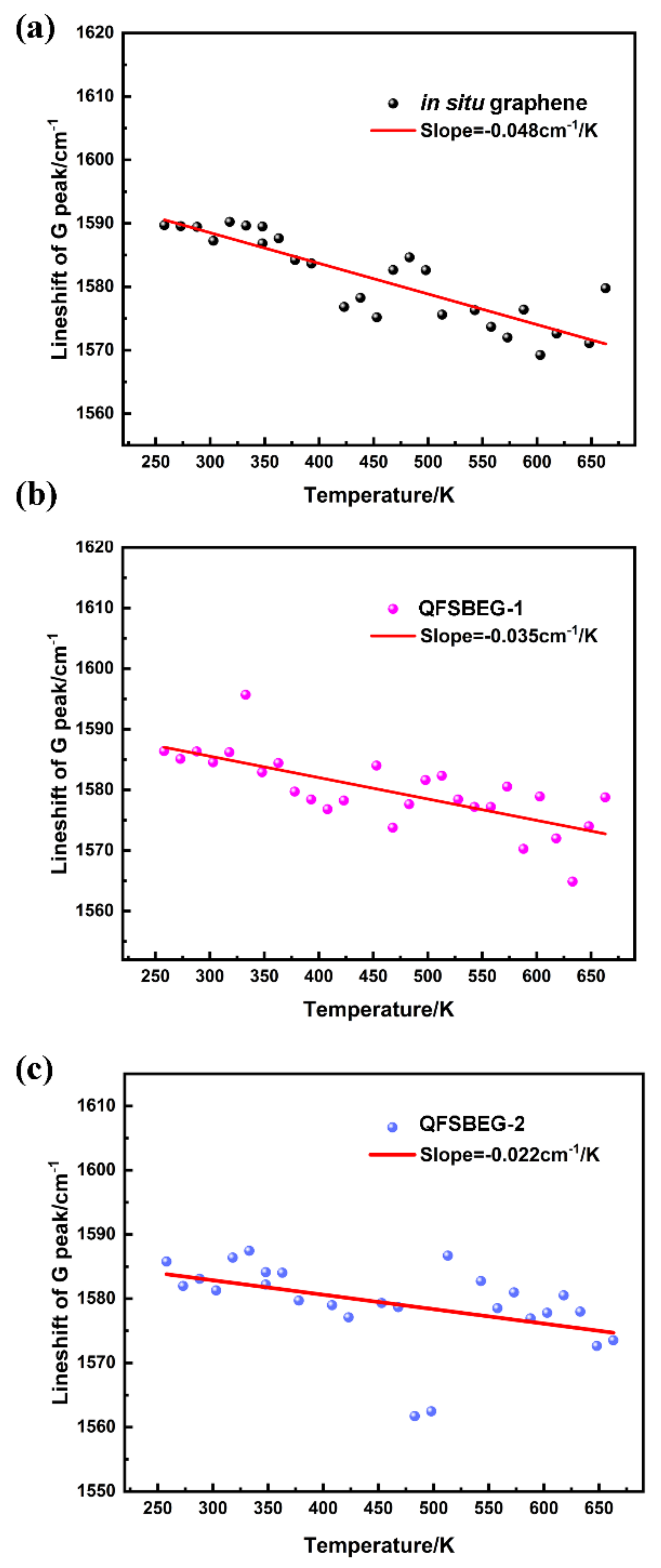Pinning and Anharmonic Phonon Effect of Quasi-Free-Standing Bilayer Epitaxial Graphene on SiC
Abstract
:1. Introduction
2. Materials and Methods
3. Results and Discussion
4. Conclusions
Supplementary Materials
Author Contributions
Funding
Informed Consent Statement
Data Availability Statement
Acknowledgments
Conflicts of Interest
References
- Kruskopf, M.; Pakdehi, D.M.; Pierz, K.; Wundrack, S.; Stosch, R.; Dziomba, T.; Götz, M.; Baringhaus, J.; Aprojanz, J.; Tegenkamp, C.; et al. Comeback of Epitaxial Graphene for Electronics: Large-Area Growth of Bilayer-Free Graphene on SiC. 2D Mater. 2016, 3, 041002. [Google Scholar] [CrossRef]
- Chen, Y.; Gong, X.L.; Gai, J.G. Progress and Challenges in Transfer of Large-Area Graphene Films. Adv. Sci. 2016, 3, 1500343. [Google Scholar] [CrossRef]
- Shtepliuk, I.; Iakimov, T.; Khranovskyy, V.; Eriksson, J.; Giannazzo, F.; Yakimova, R. Role of the Potential Barrier in the Electrical Performance of the Graphene/SiC Interface. Crystals 2017, 7, 162. [Google Scholar] [CrossRef] [Green Version]
- Varchon, F.; Feng, R.; Hass, J.; Li, X.; Nguyen, B.N.; Naud, C.; Mallet, P.; Veuillen, J.-Y.; Berger, C.; Conrad, E.H.; et al. Electronic Structure of Epitaxial Graphene Layers on SiC: Effect of the Substrate. Phys. Rev. Lett. 2007, 99, 126805. [Google Scholar] [CrossRef] [PubMed] [Green Version]
- Fromm, F.; Oliveira, M.H., Jr.; Molina-Sánchez, A.; Hundhausen, M.; Lopes, J.M.J.; Riechert, H.; Wirtz, L.; Seyller, T. Contribution of the Buffer Layer to the Raman Spectrum of Epitaxial Graphene on SiC (0001). New J. Phys. 2013, 15, 043031. [Google Scholar] [CrossRef] [Green Version]
- Ostler, M.; Fromm, F.; Koch, R.J.; Wehrfritz, P.; Speck, F.; Vita, H.; Böttcher, S.; Horn, K.; Seyller, T. Buffer Layer Free Graphene on SiC (0001) Via Interface Oxidation in Water Vapor. Carbon 2014, 70, 258–265. [Google Scholar] [CrossRef]
- Caffrey, N.M.; Johansson, L.I.; Xia, C.; Armiento, R.; Abrikosov, I.A.; Jacobi, C. Structural and Electronic Properties of Li-Intercalated Graphene on SiC(0001). Phys. Rev. B 2016, 93, 195421. [Google Scholar] [CrossRef] [Green Version]
- Fiori, S.; Murata, Y.; Veronesi, S.; Rossi, A.; Coletti, C.; Heun, S. Li-Intercalated Graphene on SiC(0001): An STM study. Phys. Rev. B 2017, 96, 125429. [Google Scholar] [CrossRef] [Green Version]
- Yurtsever, A.; Onoda, J.; Iimori, T.; Niki, K.; Miyamachi, T.; Abe, M.; Mizuno, S.; Tanaka, S.; Komori, F.; Sugimoto, Y. Effects of Pb Intercalation on the Structural and Electronic Properties of Epitaxial Graphene on SiC. Small 2016, 12, 3956–3966. [Google Scholar] [CrossRef]
- Riedl, C.; Coletti, C.; Iwasaki, T.; Zakharov, A.A.; Starke, U. Quasi-Free-Standing Epitaxial Graphene on SiC Obtained by HyDrogen Intercalation. Phys. Rev. Lett. 2009, 103, 246804. [Google Scholar] [CrossRef] [Green Version]
- Ristein, J.; Mammadov, S.; Seyller, T. Origin of Doping in Quasi-Free-Standing Graphene on Silicon Carbide. Phys. Rev. Lett. 2012, 108, 246104. [Google Scholar] [CrossRef] [Green Version]
- Yu, C.; He, Z.Z.; Li, J.; Song, X.B.; Liu, Q.B.; Cai, S.J.; Feng, Z.H. Quasi-Free-Standing Bilayer Epitaxial Graphene Field-Effect Transistors on 4H-SiC (0001) Substrates. Appl. Phys. Lett. 2016, 108, 013102. [Google Scholar] [CrossRef]
- Melios, C.; Spencer, S.; Shard, A.; Strupiński, W.; Silva, S.R.P.; Kazakova, O. Surface and Interface Structure of Quasi-Free Standing Graphene on SiC. 2D Mater. 2016, 3, 25023. [Google Scholar] [CrossRef] [Green Version]
- Kunc, J.; Rejhon, M.; Hlidek, P. Hydrogen Intercalation of Epitaxial Graphene and Buffer Layer Probed by Mid-Infrared Absorption and Raman Spectroscopy. AIP Adv. 2018, 8, 045015. [Google Scholar] [CrossRef] [Green Version]
- Cheng, R.; Bai, J.; Liao, L.; Zhou, H.; Chen, Y.; Liu, L.; Lin, Y.-C.; Jiang, S.; Huang, Y.; Duan, X. High-Frequency Self-Aligned Graphene Transistors with Transferred Gate Stacks. Proc. Natl. Acad. Sci. USA 2012, 109, 11588–11592. [Google Scholar] [CrossRef] [Green Version]
- Ferrari, A.C.; Meyer, J.C.; Scardaci, V.; Casiraghi, C.; Lazzeri, M.; Mauri, F.; Piscanec, S.; Jiang, D.; Novoselov, K.S.; Roth, S.; et al. Raman Spectrum of Graphene and Graphene Layers. Phys. Rev. Lett. 2006, 97, 187401. [Google Scholar] [CrossRef] [PubMed] [Green Version]
- Lee, D.S.; Riedl, C.; Krauss, B.; von Klitzing, K.; Starke, U.; Smet, J.H. Raman Spectra of Epitaxial Graphene on SiC and of Epitaxial Graphene Transferred to SiO2. Nano Lett. 2008, 8, 4320–4325. [Google Scholar] [CrossRef] [PubMed] [Green Version]
- Ferralis, N.; Maboudian, R.; Carraro, C. Evidence of Structural Strain in Epitaxial Graphene Layers on 6H-SiC (0001). Phys. Rev. Lett. 2008, 101, 156801. [Google Scholar] [CrossRef] [PubMed] [Green Version]
- Das, A.; Pisana, S.; Chakraborty, B.; Piscanec, S.; Saha, S.K.; Waghmare, U.V.; Novoselov, K.S.; Krishnamurthy, H.R.; Geim, A.K.; Ferrari, A.C.; et al. Monitoring Dopants by Raman Scattering in an Electrochemically Top-Gated Graphene Transistor. Nat. Nanotechnol. 2008, 3, 210–215. [Google Scholar] [CrossRef] [Green Version]
- Yang, R.; Shi, Z.; Zhang, L.; Shi, D.; Zhang, G. Observation of Raman G-Peak Split for Graphene Nanoribbons with Hydrogen-Terminated Zigzag Edges. Nano Lett. 2011, 11, 4083–4088. [Google Scholar] [CrossRef]
- Speck, F.; Jobst, J.; Fromm, F.; Ostler, M.; Waldmann, D.; Hundhausen, M.; Weber, H.B.; Seyller, T. The Quasi-Free-Standing Nature of Graphene on H-Saturated SiC(0001). Appl. Phys. Lett. 2011, 99, 122106. [Google Scholar] [CrossRef] [Green Version]
- Ni, Z.H.; Chen, W.; Fan, X.F.; Kuo, J.L.; Yu, T.; Wee, A.T.S.; Shen, Z.X. Raman Spectroscopy of Epitaxial Graphene on a SiC Substrate. Phys. Rev. B 2008, 77, 115416. [Google Scholar] [CrossRef] [Green Version]
- Grodecki, K.; Blaszczyk, J.A.; Strupiński, W.; Wysmolek, A.; Stepniewski, R.; Drabinska, A.; Sochacki, M.; Dominiak, A.; Baranowski, J.M. Pinned and Unpinned Epitaxial Graphene Layers on SiC Studied by Raman Spectroscopy. J. Appl. Phys. 2012, 111, 114307. [Google Scholar] [CrossRef]
- Ferralis, N.; Maboudian, R.; Carraro, C. Determination of Substrate Pinning in Epitaxial and Supported Graphene Layers Via Raman Scattering. Phys. Rev. B 2011, 83, 081410. [Google Scholar] [CrossRef] [Green Version]
- Calizo, I.; Balandin, A.A.; Bao, W.; Miao, F.; Lau, C.N. Temperature Dependence of the Raman Spectra of Graphene and Graphene Multilayers. Nano Lett. 2007, 7, 2645–2649. [Google Scholar] [CrossRef]
- Bonini, N.; Lazzeri, M.; Marzari, N.; Mauri, F. Phonon Anharmonicities in Graphite and Graphene. Phys. Rev. Lett. 2007, 99, 176802. [Google Scholar] [CrossRef] [PubMed] [Green Version]
- Cai, W.; Moore, A.; Zhu, Y.; Li, X.; Chen, S.; Shi, L.; Ruoff, R.S. Thermal Transport in Suspended and Supported Monolayer Graphene Grown by Chemical Vapor Deposition. Nano Lett. 2010, 10, 1645–1651. [Google Scholar] [CrossRef]
- Klemens, P.G. Anharmonic Decay of Optical Phonons. Phys. Rev. 1966, 148, 845. [Google Scholar] [CrossRef]
- Tang, H.; Herman, I.P. Raman Microprobe Scattering of Solid Silicon and Germanium at the Melting Temperature. Phys. Rev. B 1991, 43, 2299. [Google Scholar] [CrossRef]
- Mohiuddin, T.M.G.; Lombardo, A.; Nair, R.R.; Bonetti, A.; Savini, G.; Jalil, R.; Bonini, N.; Basko, D.M.; Galiotis, C.; Marzari, N.; et al. Uniaxial Strain in Graphene by Raman Spectroscopy: G Peak Splitting, Grüneisen Parameters, and Sample Orientation. Phys. Rev. B 2009, 79, 205433. [Google Scholar] [CrossRef]
- Tsang, D.K.L.; Marsden, B.J.; Fok, S.L.; Hall, G. Graphite Thermal Expansion Relationship for Different Temperature Ranges. Carbon 2005, 43, 2902–2906. [Google Scholar] [CrossRef]
- Lin, J.; Guo, L.; Huang, Q.; Jia, Y.; Li, K.; Lai, X.; Chen, X. Anharmonic Phonon Effects in Raman Spectra of Unsupported Vertical Graphene Sheets. Phys. Rev. B 2011, 83, 125430. [Google Scholar] [CrossRef] [Green Version]
- Xie, X.; Peng, Y.; Zhang, F.; Wang, R.; Chen, X.; Hu, X.; Xu, X. Anharmonic Effect on First-Order Raman Modes of P-Type 6H-SiC Single Crystals. J. Alloy. Compd. 2017, 691, 1033–1039. [Google Scholar] [CrossRef]
- Luo, X.; Liang, G.; Sun, X.; Li, Y.; Yu, F.; Wei, L.; Cheng, X.; Sun, L.; Zhao, X. Charge-Neutral Epitaxial Graphene on 6H–SiC(0001) Via FeSi Intercalation. Carbon 2020, 156, 187–193. [Google Scholar] [CrossRef]
- Bergman, L.; Alexson, D.; Murphy, P.L.; Nemanich, R.J.; Dutta, M.; Stroscio, M.A.; Balkas, C.; Shin, H.; Davis, R.F. Raman Analysis of Phonon Lifetimes in AlN and GaN of Wurtzite Structure. Phys. Rev. B 1999, 59, 12977–12982. [Google Scholar] [CrossRef] [Green Version]
- Beechem, T.; Graham, S. Temperature and Doping Dependence of Phonon Lifetimes and Decay Pathways in GaN. J. Appl. Phys. 2008, 103, 093507. [Google Scholar] [CrossRef]





| Sample | dω/dT (cm−1/K) | T Range (K) | Theory |
|---|---|---|---|
| Freestanding [25,26] | −0.009 ± 0.002 | 150–250 | −0.011 |
| −0.015 ± 0.003 | 300–400 | −0.017 | |
| Pressed on SiO2/Si [24] | −0.052 ± 0.004 | 300–400 | −0.046 |
| On Au/SiN/Si [27] | −0.040 ± 0.002 | 400–500 | −0.052 |
| In situ grown epitaxial graphene [24] | −0.043 ± 0.013 | 300–400 | −0.048 |
| In situ grown epitaxial graphene in this study | −0.048 ± 0.005 | 258–663 | |
| QFSBEG-1 in this study | −0.035 ± 0.006 | 258–663 | |
| QFSBEG-2 in this study | −0.022 ± 0.008 | 258–663 |
| In Situ Graphene | QFSBEG-1 | QFSBEG-2 | |
|---|---|---|---|
| Ω0 (cm−1) | 1713.68 | 1643.37 | 1647.93 |
| M1 | −149.01 | −64.50 | −79.20 |
| M2 | 31.43 | 14.95 | 21.44 |
| M1/M2 | 4.74 | 4.31 | 3.69 |
| Temperature | In Situ Graphene | QFSBEG-1 | QFSBEG-2 | |||
|---|---|---|---|---|---|---|
| (cm−1) | τ (ps) | (cm−1) | τ (ps) | (cm−1) | τ (ps) | |
| 273 K | 18.557 | 0.286 | 13.099 | 0.405 | 16.036 | 0.331 |
| 303 K | 19.969 | 0.265 | 15.549 | 0.341 | 11.576 | 0.458 |
| 333 K | 28.387 | 0.187 | 16.756 | 0.316 | 10.724 | 0.494 |
| 363 K | 9.075 | 0.584 | 15.888 | 0.334 | 11.751 | 0.451 |
| 393 K | 4.788 | 1.107 | 11.803 | 0.449 | 8.007 | 0.662 |
| 423 K | 4.348 | 1.219 | 30.242 | 0.175 | 7.520 | 0.705 |
Publisher’s Note: MDPI stays neutral with regard to jurisdictional claims in published maps and institutional affiliations. |
© 2022 by the authors. Licensee MDPI, Basel, Switzerland. This article is an open access article distributed under the terms and conditions of the Creative Commons Attribution (CC BY) license (https://creativecommons.org/licenses/by/4.0/).
Share and Cite
Sun, L.; Wang, P.; Xie, X.; Chen, X.; Yu, F.; Li, Y.; Xu, X.; Zhao, X. Pinning and Anharmonic Phonon Effect of Quasi-Free-Standing Bilayer Epitaxial Graphene on SiC. Nanomaterials 2022, 12, 346. https://doi.org/10.3390/nano12030346
Sun L, Wang P, Xie X, Chen X, Yu F, Li Y, Xu X, Zhao X. Pinning and Anharmonic Phonon Effect of Quasi-Free-Standing Bilayer Epitaxial Graphene on SiC. Nanomaterials. 2022; 12(3):346. https://doi.org/10.3390/nano12030346
Chicago/Turabian StyleSun, Li, Peng Wang, Xuejian Xie, Xiufang Chen, Fapeng Yu, Yanlu Li, Xiangang Xu, and Xian Zhao. 2022. "Pinning and Anharmonic Phonon Effect of Quasi-Free-Standing Bilayer Epitaxial Graphene on SiC" Nanomaterials 12, no. 3: 346. https://doi.org/10.3390/nano12030346
APA StyleSun, L., Wang, P., Xie, X., Chen, X., Yu, F., Li, Y., Xu, X., & Zhao, X. (2022). Pinning and Anharmonic Phonon Effect of Quasi-Free-Standing Bilayer Epitaxial Graphene on SiC. Nanomaterials, 12(3), 346. https://doi.org/10.3390/nano12030346










